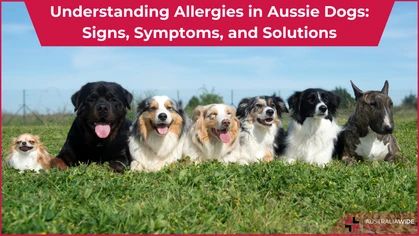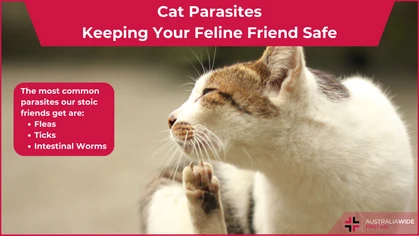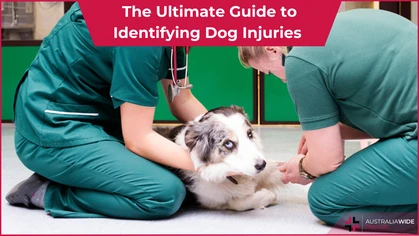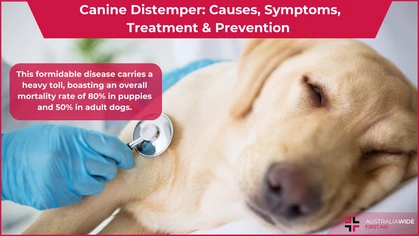First Aid for Dogs: Paw Care

Pets
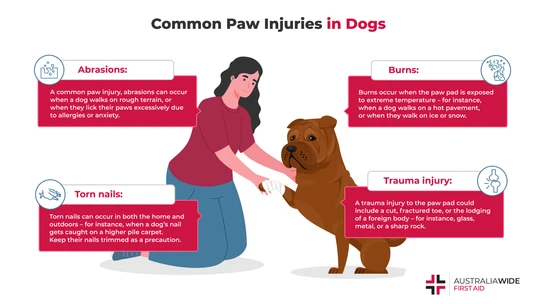
A dog paw injury is typically not life-threatening and can be managed using basic first aid principles.
A dog’s paws are tough, but injuries happen. Learning how to treat common paw injuries using basic first aid will empower you to manage your dog’s injuries with confidence and know when to seek professional help. Some paw injuries are obvious. You may hear your dog yelp in pain from an acute traumatic injury. Other times, the injury reveals itself later when he begins to limp or lick his paws excessively. Below we will review common dog paw injuries as well as the symptoms and first aid treatment for each.Abrasions
Abrasions to paw pads can occur for various reasons, so it is a common injury. Walking on rough terrain can cause small scratches and surface injury. Excessive licking from allergies or anxiety can also abrade the paw pads.Symptoms
- Red, raw appearing pads
- Tip-toe stance
- Excessive licking of paws
- Light, generalized bleeding of paw pads
- Limping
Treatment
- Clean the paw pad with mild soap and cool water
- Rest
- Time. It may take 1-2 weeks for the pads to heal
Burns
Burn injury occurs when the paw pad is exposed to extreme temperature. It is very common in the summer when pavement temperatures soar. Interestingly, burns can also occur when the pads are exposed to very cold temperatures when walking on ice or snow.Symptoms
- Blisters or open sores on paw pads
- Red, raw appearing pads
- Missing/torn parts of paw pad
- Tip-toe stance
- Limping
- Excessive licking of paws
Treatment
- Clean the paw with mild soap and cool water
- Bandage: see the bandaging section below for bandaging techniques
- Rest
- Seek professional medical care to evaluate wound
Torn Nails
This type of injury occurs often at home as well as on the trails and outdoors. Carpet is a common cause of nail injury, particularly higher pile carpet. Keeping your dog’s nails trimmed helps to prevent this type of injury.Symptoms
- Nail is visibly split
- Excessive licking of the affected foot
Treatment
- Trim the other nails
- If the nail is completely split, remove torn nail using hemostats or pliers. Grasp the affected toenail firmly and pull away quickly
- If the nail is only partially split, or fully split but you are unable to remove it, trim the nail as short as possible until you can seek professional help
- Trim small portions of the nails until the desired length is achieved. Take care not to trim into the quick which causes bleeding
- Clean with an antiseptic cleanser as available, or with soap and water
- Seek professional care as soon as possible to evaluate the wound and assess the need for antibiotics
Trauma Injury
A trauma injury to the foot pad could be a cut injury, a fractured toe, or the lodging of a foreign body. Common foreign bodies that get lodged into the foot pad include glass, metal, sharp rock, cactus needles, thorns, and foxtail seed.Symptoms
- Red, inflamed area between toes
- Drainage of pus in the affected area
- Limping
- Excessive licking of paws
- Visible foreign body in paw
- Swelling and lameness in the case of fracture
- Bleeding
Treatment
- Remove any foreign bodies
- Clean with an antiseptic cleanser as available, or with soap and water
- Apply antibiotic ointment
- Bandage: see the bandaging section below for bandaging techniques
- Seek professional care as soon as possible to evaluate the wound and assess the need for antibiotics
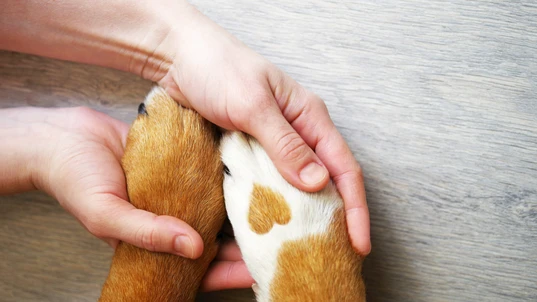
Pet owners can apply basic first aid principles to dogs in case of injury.
Bandaging
Supplies You Will Need
- Telfa (or other non-stick) pads
- Padding – may use gauze or a cotton material
- Wrap – may be the same material as the padding
- Tape
- Splint material (optional) – may be cardboard, sticks, boards, etc.
Technique
Apply a non-stick pad to the site of injury. Apply padding and pressure over the injury to stop bleeding. Wrap the affected foot in a figure-8 pattern. If you have multiple wrapping items on hand, wrap the foot first with gauze, then with a stretch material over the top. Apply tape over the bandage to stabilize the wrap. When wrapping the foot, push the foot into its weight-bearing position so that the wrap is stabilized and not too tight when the foot returns to its natural standing position.Prevention
Some wounds and injuries can be prevented with a little preparation. If you plan to take your dog on an extended trail hike, precondition the paw pads to rough terrain to toughen up the pads. Keep the nails well-trimmed and regularly condition your dog to nail trimming practices. In the heat of summer take walks in the early morning or evening to avoid hot pavement. Modify or shorten walks over snow and ice to avoid cold injury. Consider introducing your dog to booties that cover and protect the paw pads. Do not introduce the booties on the trail when they are immediately necessary. Your dog will likely need time to acclimate to boot-wearing. While boots can protect your dog’s paws, they can also hide injuries. Take care to inspect your dog’s paws regularly during boot use. Keep a first aid kit on hand during longer trail hikes or when you will be away from home.Conclusion
Conservative management of paw injuries in the field or at home is encouraged. In the case of injury, implement the first aid techniques described above and seek professional help as needed. Most paw injuries can heal on their own without the need for surgical intervention. Time and rest are the most valuable healing techniques. In the following cases, you should consider seeking professional veterinary care:- Uncontrolled bleeding
- Large foreign objects embedded in the paw
- Deep wounds requiring stitches
- Suspected infections
Originally published at
https://www.australiawidefirstaid.com.au/resources/paw-care-for-dogs
as part of the Australia Wide First Aid Articles Library
